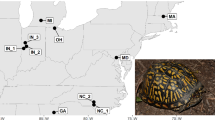Summary
Two experiments were conducted to deterine whether territorial male Red-winged Blackbirds discriminate among neighbor, stranger, and self songs. In the first experiment, recordings of the three classes of songs were played to territorial males. Responses to playback of stranger song, as measured by song rate, intensity of Song Spread display, and closest approach, were significantly stronger than to playback of neighbor song. In addition, stranger song elicited significantly more intense Song Spread displays than did self song.
In the second experiment, territorial males were removed from their territories and each was replaced with speakers broadcasting recorded songs of a stranger, and of the removed male. Broadcasts of the removed male's own songs were more effective in discouraging trespassing by neighboring male redwings than were broadcasts of songs of a stranger. However, the two broadcasts did not differ in their ability to deter nonneighboring male redwings from flying through or trespassing within the speaker territory.
We suggest that neighbor-stranger discrimination in the Red-winged Blackbird develops as a consequence of associative learing.
Similar content being viewed by others
References
Beletsky LD, Chao S, Smith DG (1980) An investigation of songbased species recognition in the Red-winged Blackbird. Behaviour 73:189–203
Brenowitz EA (1982) Long-range communication of species identity by song in the Red-winged Blackbird. Behav Ecol Sociobiol 10:29–38
Brooks RJ, Falls JB (1975) Individual recognition by song in White-throated Sparrows. I. Discrimination of songs of neighbors and strangers. Can J Zool 53:879–888
Emlen ST (1971) The role of song in individual recognition in the Indigo Bunting. Z Tierpsychol 28:241–246
Falls JB (1963) Properties of bird song eliciting responses from territorial males. Proc XIII Int Ornithol Congr 259–271
Falls JB, Brooks RJ (1975) Individual recognition by song in White-throated Sparrows. II. Effects of location. Can J Zool 53:1412–1420
Goldman P (1973) Song recognition by Field Sparrows. Auk 90:106–117
Harris MA, Lemon RE (1976) Responses of male Song Sparrows Melospiza melodia to neighbouring and non-neighbouring individuals. Ibis 118:421–424
Hinde RA (1958) Alternative motor patterns in Chaffinch song. Anim Behav 6:211–218
Krebs JR (1971) Territory and breeding density in the Great Tit, Parus major L. Ecology 52:2–22
Krebs JR (1977) The significance of song repertoires: the Beau Geste hypothesis. Anim Behav 25:465–478
Krebs JR, Ashcroft R, Webber M (1978) Song repertoires and territory defence in the Great Tit. Nature 271:539–542
Kroodsma DE (1976) The effect of large song repertoires on neighbor ‘recognition’ in male Song Sparrows. Condor 78:97–99
Marler P, Peters S (1981) Birdsong and speech: evidence for special processing. In: Eimas P (ed) Perspectives on the study of speech. Erlbaum Associates, Hillsdale, New Jersey, pp 75–112
Marler P, Mundinger P, Waser MS, Lutjen A (1972) Effects of acoustical stimulation and deprivation on song development in Red-winged Blackbirds (Agelaius phoeniceus). Anim Behav 20:586–606
Nero RW (1956) A behavior study of the Red-winged Blackbird: II. Territoriality. Wilson Bull 68:129–150
Nottebohm F (1972) Neural lateralization of vocal control in a passerine bird. II. Subsong, calls, and a theory of vocal learning. J Exp Zool 179:35–49
Patterson TL, Petrinovich L (1979) Field studies of habituation: II. Effect of massed stimulus presentation. J Comp Physiol Psychol 93:351–359
Payne RB (1978) Microgeographic variation in songs of splendid sumbirds Nectarinia coccinigaster: population phenetics, habitats and song dialects. Behaviour 65:282–308
Payne RB (1981) Song learning and social interation in indigo buntings. Anim Behav 29:688–697
Petronovich L, Patterson TL (1979) Field studies of habituation: I. Effect of reproductive condition, number of trials, and different delay intervals on responses of the White-crowned Sparrow. J Comp Physiol Psychol 93:337–350
Richards DG (1979) Recognition of neighbors by associative learning in Rufous-sided Towhees. Auk 96:688–693
Searey WA, McArthur PD, Peters SS, Marler P (1981) Response of male Song and Swamp Sparrows to neighbour, stranger, and self songs. Behaviour 77:152–163
Siegel S (1956) Nonparametric statistics for the behavioral sciences. McGraw-Hill, New York
Slater PBJ (1981) Chaffinch song repertoires: observations, experiments and a discussion of their significance. Z Tierpsychol 56:1–24
Smith DG (1976) An experimental analysis of the function of Red-winged Blackbird song. Behaviour 56:136–156
Smith DG, Reid FA (1979) Roles of the song repertoire in Red-winged Blackbirds. Behav Ecol Sociobiol 5:279–290
Weeden JS, Falls JB (1959) Differential responses of male Ovenbirds to recorded songs of neighboring and more distant individuals. Auk 76:323–351
Wiley RH, Wiley MS (1977) Recognition of neighbour's duets by Stripe-backed Wrens (Campylorhynchus muchalis). Behaviour 62:10–34
Wunderle JM (1978) Differential response of territorial Yellowthroats to the songs of neighbors and non-neighbors. Auk 95:389–395
Yasukawa K (1978) Aggressive tendencies and levels of a graded display: factor analysis of response to song playback in the Red-winged Blackbird (Agelaius phoeniceus). Behav Biol 23:446–459
Yasukawa K (1979) Territory establishment in Red-winged Blackbirds: importance of aggressive behavior and experience. Condor 81:258–264
Yasukawa K (1981a) Song and territory defense in the Red-winged Blackbird. Auk 98:185–187
Yasukawa K (1981b) Song repertoires in the Red-winged Blackbird (Agelaius phoeniceus): a test of the Beau Geste hypothesis. Anim Behav 29:114–125
Yasukawa K, Blank JL, Patterson CB (1980) Song repertoires and sexual selection in the Red-winged Blackbird. Behav Ecol Sociobiol 7:233–238
Author information
Authors and Affiliations
Rights and permissions
About this article
Cite this article
Yasukawa, K., Bick, E.I., Wagman, D.W. et al. Playback and speaker-replacement experiments on song-based neighbor, stranger, and self discrimination in male Red-winged Blackbirds. Behav Ecol Sociobiol 10, 211–215 (1982). https://doi.org/10.1007/BF00299687
Received:
Accepted:
Issue Date:
DOI: https://doi.org/10.1007/BF00299687




